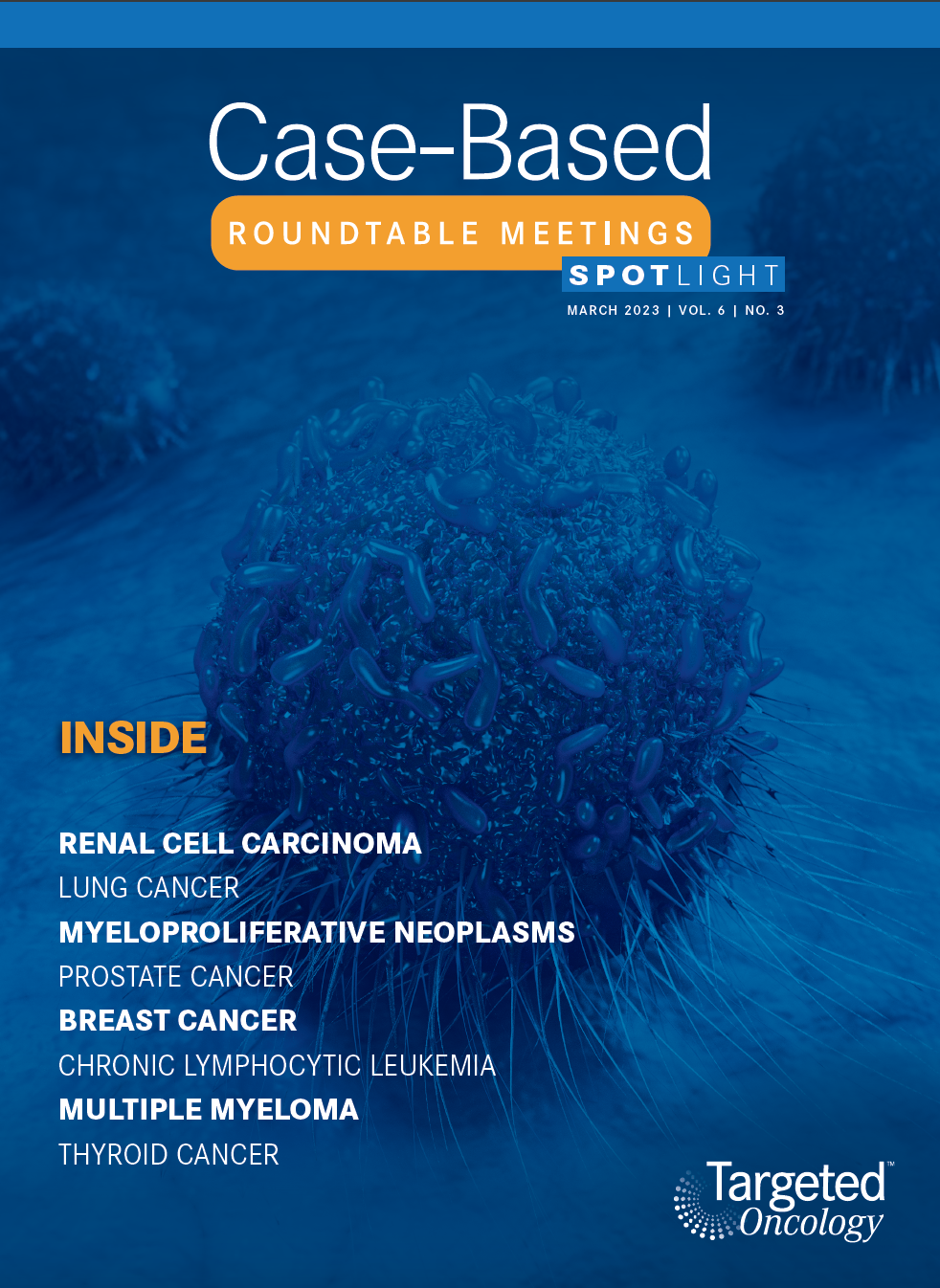Poll: How Would You Treat a Patient With NSCLC and an EGFR Exon 20 Insertion Mutation?
During a Targeted Oncology™ Case-Based Roundtable™ event, Joel Neal, MD, PhD, discussed what options physicians would choose when treating a patient with non–small cell lung cancer who tested positive for an EGFR exon 20 insertion.
Joel Neal, MD, PhD (Moderator)
Associate Professor
Division of Oncology
Stanford Cancer Institute
Stanford University
Palo Alto, CA


CASE SUMMARY
A 64-year-old man presented with worsening fatigue, persistent dry cough, and mild progressive dyspnea over the past month, as well as some chest discomfort, especially during routine exercise. He had unintentional weight loss of 8 lbs over the past 4 months. He has a medical history of hypertension and hypercholesterolemia, which are both well controlled with medication. He is the father of 2 children and has never been a smoker.
A right lower lobe auscultation revealed decreased breath sounds. His ECOG performance status was1. A CT scan of the chest showed a 3.5-cm mass in the right lower lobe, a small right pleural effusion with nodularity, and mediastinal lymph node involvement. A PET/CT scan showed multiple bone metastases, including vertebrae and left scapula. A brain MRI was negative for metastasis. A mediastinal node endobronchial ultrasound confirmed the patient had stage IVB non–small cell lung cancer (NSCLC), TTF1-positive adenocarcinoma.
What would your approach be toward molecular testing for this patient?
NEAL: Would anybody do next-generation sequencing [NGS] alone—Tempus, Foundation Medicine, etc? Or are you doing NGS plus other things right now?
DEKKER: We’re doing NGS, fluorescence in situ hybridization [FISH], and immunohistochemistry [IHC].
NEAL: So a bunch of them all together.
DEKKER: We call it hot-spot for actionable [items].
JANG: I do NGS testing. In our institution, we are switching from Strata [Oncology] to Caris [Life Sciences]. Now I think they’re doing DNA- and RNA-based NGS together, so that’s great. We can maybe pick up some other rare fusions.
I think that’s where we’re heading. We don’t routinely do liquid biopsy unless there’s a difficulty in terms of getting a tissue or nondiagnostic result.
NEAL: You’re at Kaiser Permanente Riverside [Medical Center], so is all of Kaiser moving away from Strata and going toward Caris?
JANG: Yes, in [Southern] California for sure.
SACHDEV: Which mutation would you do polymerase chain reaction [PCR] for?
NEAL: Classically, the PCR mutations are the ones that are single-point mutations, small insertions, or deletions. So all of EGFR is very amenable to PCR; BRAF, we only have V600E as actionable right now; ERBB2 exon 20 insertions; and KRAS— those are the ones we could PCR test for.
We’re still doing PCR for EGFR of just hot-spot mutations and a rapid assay. We’re not sequencing the whole thing. We’re just putting it on and sequencing with a couple of days turnaround so that we don’t have to wait for NGS because EGFR is so much more common than all the other ones.
In the United States patient population, there is a 15% frequency, but when we think about Asian women, never smokers, you’re up to a 50% to 60% frequency, which I know many of us on the West Coast will see these patients newly diagnosed and presenting [in the clinic]. So I like to have that EGFR test back very quickly, and then the rest of it we can wait for by NGS. To stress again, PD-L1 [testing is] only by IHC, only on the tissue, and can vary depending on where we biopsy.
CASE UPDATE
The patient’s PD-L1 expression is negative, and the results of molecular testing by tissue DNA NGS are pending.
The patient is anxious to initiate therapy. What are you most likely to offer this patient as first-line therapy (assuming a clinical trial is not available)?
NEAL: The patient is anxious to initiate therapy. What are you going to offer? The patient is symptomatic, needs therapy, [is a] never smoker, [and is] TTF1 positive. What are you going to do?
DEKKER: When I say chemotherapy, I usually mean I add bevacizumab [Avastin] as well.
NEAL: Platinum doublet can include an antiangiogenic.
CHAND: [What about] for a patient who has 2 mutations like EGFR and [MET] exon 14?
NEAL: My personal bias is to try to treat the more common one, and the less common one is statistically more likely to be a false-positive for whatever reason. But it is certainly possible to have acquired resistance of a second driver with an initial driver. Most of our cases where we have EGFR plus ALK or EGFR plus ROS1, they were false-positive FISH tests, and the EGFR was the driver alteration as evidenced by the EGFR-targeted treatment working.
I personally might hold off on the antiangiogenic and leave it until cycle 2 if we don’t find another molecular alteration. A decade ago, I would say EGFR mutations, let’s go ahead and treat with platinum and then at the point of progression, use a tyrosine kinase inhibitor [TKI] in the second line. But I think many of these drugs look so much better that I don’t have a problem switching after cycle 1. If the patient was in the hospital though, I probably wouldn’t give an antiangiogenic. If the PD-L was 90%, I still would hold off on immunotherapy here.
CASE UPDATE
The patient was started on doublet chemotherapy (cisplatin and pemetrexed). Tissue NGS showed an EGFR exon 20 insertion mutation (V769_ D770insASV). Now, 4 months after initiation of chemotherapy with an initial partial response, the patient is reporting worsening back pain and shortness of breath. A CT scan shows disease progression. Repeat brain MRI shows no metastases.
NEAL: Started on chemotherapy doublet with cisplatin. Bold move. I probably would have gone with carboplatin/pemetrexed. There are lots of different nomenclature with the EGFR exon 20 insertions, but the only one that is different is the FQEA.
Who’s had a patient test positive for EGFR exon 20 insertion?
CHAND: I had one a long time ago before there was anything approved for exon 20. Ever since the medication [has been] out, I haven’t had a single one. I sequence all my patients.
NEAL: I certainly remember being frustrated at the lack of effective therapies that we had for patients with EGFR exon 20 mutations. The platinum pemetrexed worked pretty well, but then after that, not much worked. The central nervous system [CNS] metastases and the leptomeningeal disease were definitely a problem. The EGFR exon 20 mutation 763_Y764insFQEA can be quite exquisitely sensitive to TKIs, and hopefully molecular testing reports will point that out.
The other footnote EGFR mutation is the T790M mutation.… Our third-generation TKIs now inhibit and prevent the development of T790M. We don’t see it very much anymore.
What are you most likely to offer this patient as next-line therapy (assuming a clinical trial is not available)?
NEAL: Who’s going for mobocertinib [Exkivity] and why?
DEKKER: Because I liked [the data for] it. I have not used it, but when I look at [the] data…it sounded somewhat more appealing.
NEAL: [There are] a lot of attractive things about the EGFR [oral] therapies. We’re used to the adverse events of those, so I think they make a lot of sense.
CHARU: I [don’t have] experience, but I recently had a patient with an EGFR 20 insertion [mutation]. He has metastasis to the brain, so he is getting radiation right now. But I was looking at the data—mobocertinib is a pill form, amivantamab-vmjw [Rybrevant] is intravenous, so I felt that maybe the oral medication may be better. Also, the dosing may be an issue with amivantamab, but I don’t have any experience yet.
In this patient of mine who progressed on platinum-based chemotherapy, I didn’t have enough tissue to do more testing, so I did a liquid biopsy. In fact, initially, on the tissue biopsy, they didn’t mention about exon 20 insertion, but on liquid biopsy it came back as positive. Would you go with that for treatment?
NEAL: I always believe a positive. I feel like a positive from any test could be a true positive. These tests shouldn’t have contamination, which is the only reason that would lead to a false-positive. I think a liquid biopsy is good enough to use for diagnostic purposes for sure.
With mobocertinib, we heard of maybe more CNS penetration. I’m not sure that’s true from the data that we’ve seen so far. Neither of these drugs seems to have great CNS penetration, not like we’ve seen with other TKIs.
What would be the case for amivantamab? Amivantamab is [an] EGFR/MET bispecific antibody with intravenous weekly dosing at the beginning but then goes to every 2 weeks.
JANG: If you look at cross-trial comparisons, amivantamab is probably slightly better than mobocertinib. The response rate was about 10% higher, [with amivantamab at 40% and mobocertinib at 28%].1,2
[I would not use either of these drugs to treat a patient] with CNS metastases....[Although] the response rate is not high enough...I would choose amivantamab [for this patient] because the response rate tends to be 10% higher.
NEAL: Yes, it had a higher investigator response rate, slightly higher progression-free survival [median, 8.3 months with amivantamab vs 7.3 months with mobocertinib].1,2 Not much CNS data on either of these drugs and completely different mechanisms of action. I think they’ll probably work after one another, but we have yet to see data on that. [According to the] National Comprehensive Cancer Network guidelines, [physicians can use either for a patient with an EGFR exon 20 insertion mutation].3 Then, if not previously received, you can flip to the other one. The mechanism is different.
[You should do a] repeat biopsy afterward, and we’re doing that fairly routinely in many types of NSCLC. For osimertinib [Tagrisso], I agree with the repeat biopsy afterward because we want to make sure there’s no small cell lung cancer, MET amplification, or other targetable alterations. With EGFR mutations, we’re starting to see the acquired resistance and what the mechanisms are, but I don’t know that I would favor repeat biopsy in the community setting for these. At progression, try the other one. I have a patient who’s responding after flip-flopping right now. Amivantamab and mobocertinib were FDA approved close to each other. First, amivantamab and then mobocertinib a couple of months later.
REFERENCES
1. Park K, Haura EB, Leighl NB, et al. Amivantamab in EGFR exon 20 insertion-mutated non-small-cell lung cancer progressing on platinum chemotherapy: initial results from the CHRYSALIS phase I study. J Clin Oncol. 2021;39(30):3391-3402. doi:10.1200/JCO.21.00662
2. Zhou C, Ramalingam SS, Kim TM, et al. Treatment outcomes and safety of mobocertinib in platinum-pretreated patients with EGFR exon 20 insertion-positive metastatic non-small cell lung cancer: a phase 1/2 open-label nonrandomized clinical trial. JAMA Oncol. 2021;7(12):e214761. doi:10.1001/jamaoncol.2021.4761
3. NCCN. Clinical Practice Guidelines in Oncology. Non-small cell lung cancer, version 1.2023. Accessed January 31, 2023. https://bit.ly/3kOnjzQ
